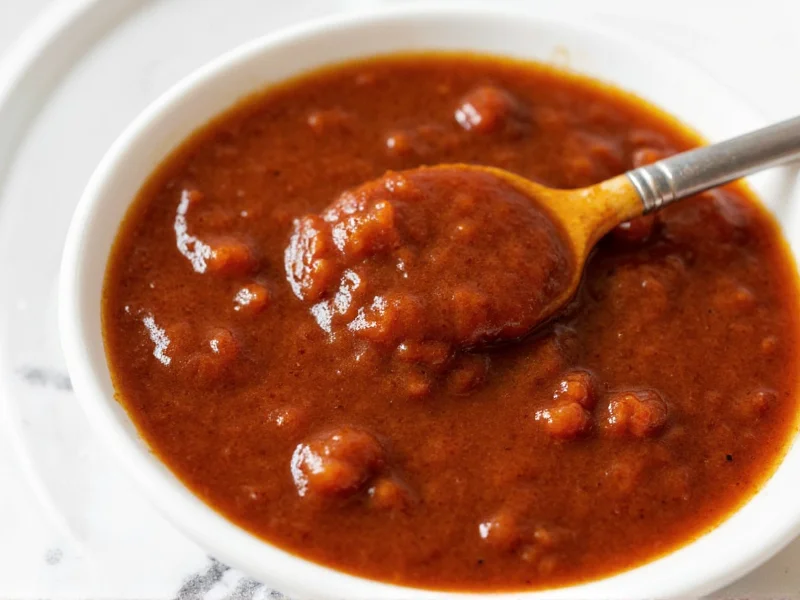Understanding the distinction between these two adobo preparations is essential for cooks exploring global cuisines. The term "adobo" entered culinary lexicon through Spanish colonization, deriving from the Spanish word "adobar" meaning "to marinate," but evolved differently in the Philippines and Mexico.
Filipino Adobo: The National Dish Foundation
Filipino adobo isn't technically a sauce you buy off the shelf—it's a cooking technique that creates a flavorful braising liquid. This preparation method likely developed as a food preservation technique in the tropical climate of the Philippines, where vinegar's acidity helped prevent spoilage.
The classic Filipino adobo preparation combines:
- Vinegar (cane or coconut vinegar preferred)
- Soy sauce
- Garlic
- Whole peppercorns
- Bay leaves
- Meat (typically chicken or pork)
As the meat braises, these ingredients combine to create a tangy, savory sauce that's considered the national dish of the Philippines in various regional iterations. Some versions incorporate coconut milk for a richer adobo sa gata, while others add pineapple for sweetness.
Mexican Adobo Sauce: The Complex Chile Blend
Mexican adobo presents a completely different profile—a thick, rich, brick-red sauce made primarily from rehydrated dried chilies. This versatile sauce serves as both a marinade and cooking base for numerous Mexican dishes.
| Characteristic | Filipino Adobo | Mexican Adobo |
|---|---|---|
| Primary Base | Vinegar and soy sauce | Dried chilies (ancho/guajillo) |
| Color | Brownish, translucent | Deep red, opaque |
| Texture | Thin braising liquid | Thick, paste-like |
| Primary Use | Cooking method and resulting sauce | Marinade, sauce base, seasoning |
| Common Commercial Form | Rarely sold as prepared sauce | Widely available canned or in packets |
Authentic Mexican adobo sauce preparation involves:
- Rehydrating dried chilies in hot water
- Blending with vinegar, garlic, cumin, and oregano
- Simmering to develop complex flavors
Many commercial versions (like the popular Goya brand) include tomato, which isn't traditional in authentic preparations but has become common in modern interpretations. This sauce forms the foundation for dishes like tinga (shredded meat in adobo sauce) and serves as a marinade for proteins before grilling or roasting.
Key Differences Every Cook Should Know
The confusion between these two preparations causes frequent culinary mishaps. When a recipe calls for "adobo sauce," always check the cultural context:
- Filipino recipes typically refer to the cooking method, not a bottled sauce
- Mexican recipes usually mean the chili-based sauce available in cans or packets
- "Adobo seasoning" refers to a dry spice blend common in Latin markets
Understanding what is adobo sauce in its proper context prevents recipe failures. If substituting, consider the flavor profile you need—tangy soy-vinegar for Filipino dishes versus smoky chili depth for Mexican preparations.
Practical Uses in Modern Cooking
Both adobo variations offer versatile applications beyond traditional recipes:
- Mexican adobo makes an excellent quick marinade for chicken thighs (30 minutes minimum)
- Filipino adobo braising liquid transforms simple vegetables like eggplant or mushrooms
- Adobo sauce adds depth to bean dishes and soups
- Thin Mexican adobo with broth for an instant enchilada sauce
- Use Filipino adobo liquid as a base for fried rice
When working with store-bought Mexican adobo sauce, balance its inherent sweetness with additional vinegar. For authentic Filipino adobo, use palm vinegar if possible, as its milder acidity better represents traditional flavor profiles.
Storage and Shelf Life Considerations
Homemade Filipino adobo sauce (the braising liquid) keeps refrigerated for up to 5 days or frozen for 3 months. Commercial Mexican adobo sauce typically remains good for 6-8 months unopened, then 1-2 weeks refrigerated after opening.
For best results when using adobo sauce in meal preparation, always taste before adding additional salt—both variations often contain significant sodium levels that may require recipe adjustments.
Exploring Authentic Adobo Sauce Recipes
When searching for what is adobo sauce in practical application, consider these authentic approaches:
- Filipino Chicken Adobo: Brown chicken pieces, then simmer with equal parts vinegar and soy sauce, 6 crushed garlic cloves, 1 tsp peppercorns, and 2 bay leaves for 30-40 minutes until tender
- Homemade Mexican Adobo: Soak 4 dried ancho chilies in hot water for 20 minutes, blend with 2 cloves garlic, ½ tsp cumin, ¼ tsp oregano, 2 tbsp vinegar, and ½ cup water until smooth
Understanding the difference between adobo the cooking technique and adobo sauce as a commercial product prevents common kitchen mistakes. When exploring traditional Filipino cooking, remember that "adobo" refers to the entire cooking process, not just a bottled sauce you add.
What's the difference between adobo and adobo sauce?
Adobo refers to a Filipino cooking method using vinegar and soy sauce, while adobo sauce specifically denotes the Mexican chili-based sauce. Filipino adobo creates its sauce during cooking, whereas Mexican adobo sauce is typically purchased as a prepared product.
Can I substitute soy sauce for adobo sauce?
No, soy sauce cannot substitute for Mexican adobo sauce as they have completely different flavor profiles. For Filipino adobo, soy sauce is actually a key ingredient in creating the sauce, but it's not a substitute for the finished product.
Is adobo sauce spicy?
Mexican adobo sauce typically has mild to moderate heat from the dried chilies, but it's more characterized by its complex, smoky flavor than intense spiciness. Filipino adobo isn't spicy at all—it's tangy and savory from the vinegar and soy sauce.
Where can I find authentic adobo sauce?
Authentic Mexican adobo sauce is widely available in Latin grocery stores, major supermarkets (usually in the international aisle), and online. For Filipino adobo, you'll need to prepare it yourself as it's a cooking method rather than a bottled product.
How do I use adobo sauce in cooking?
Mexican adobo sauce works as a marinade for meats (chicken, pork), a base for soups and stews, or thinned with broth for enchilada sauce. Filipino adobo is used as both marinade and braising liquid for meats, with the resulting sauce served over rice.











 浙公网安备
33010002000092号
浙公网安备
33010002000092号 浙B2-20120091-4
浙B2-20120091-4